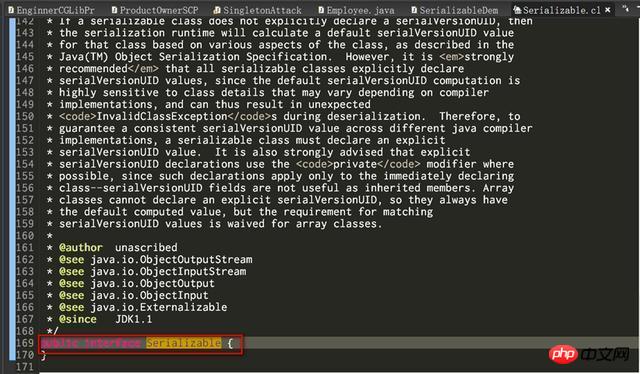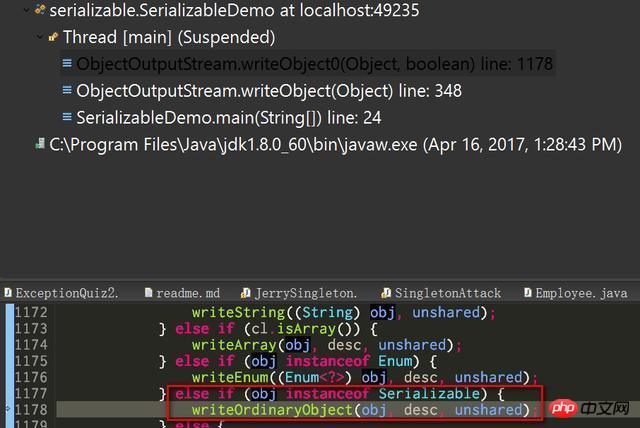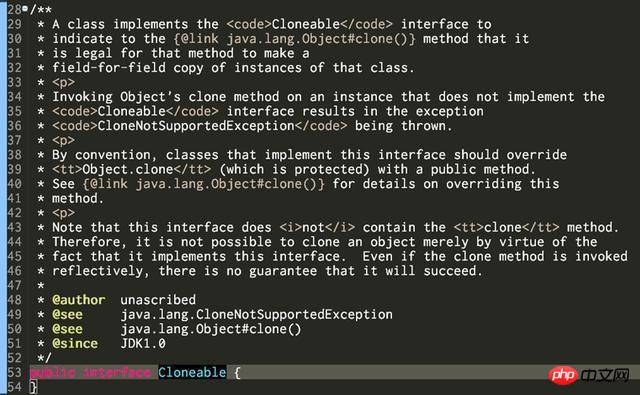What is the Java Marker Interface? Introduction to Java Markup Interface
This article brings you what is the Java Marker Interface (Marker Interface)? The introduction of Java tag interface has certain reference value. Friends in need can refer to it. I hope it will be helpful to you.
Let’s first look at what is a marker interface? Tag interface is sometimes called Tag interface, that is, the interface does not contain any methods. It is easy to find examples of marked interfaces in Java. For example, the Serializable interface in the JDK is a marked interface.

First of all, let’s make it clear that the Marker Interface is by no means unique to the Java programming language, but is a common method in computer science. design concept.
Let’s look at the definition of marker interface in Wikipedia.
“The tag/ marker interface pattern is a design pattern in computer science, used with languages that provide run-time type information about objects. It provides a means to associate metadata with a class where the language does not have explicit support for such metadata."
I tried Google Translate to translate the above paragraph, but the translation was very poor, so I will explain it.
Tagged interface is a design idea in computer science. The programming language itself does not support maintaining metadata for classes. The marker interface makes up for this lack of functionality - a class implements a marker interface without any methods. In fact, the marker interface becomes one of the metadata of this class in a sense. At runtime, through the reflection mechanism of the programming language, we can get this metadata in the code.
Take the Serializable interface as an example. A class implements this interface, indicating that it can be serialized. Therefore, we actually use the Serializable interface to mark the class with "serializable" metadata and label it as "serializable". This is where the tag/label interface gets its name.
The following code is taken from the JDK source code:
if (obj instanceof String) {
writeString((String) obj, unshared);
} else if (cl.isArray()) {
writeArray(obj, desc, unshared);
} else if (obj instanceof Enum) {
writeEnum((Enum) obj, desc, unshared);
} else if (obj instanceof Serializable) {
writeOrdinaryObject(obj, desc, unshared);
} else {
if (extendedDebugInfo) {
throw new NotSerializableException(cl.getName() + " "
+ debugInfoStack.toString());
} else {
throw new NotSerializableException(cl.getName());
}
}Serialization in Java, strings, arrays, enumeration classes and ordinary classes are performed separately. If the variable currently to be serialized is neither a string nor an array or enumeration class, then it is checked whether the class implements the Serializable interface. Please note that line 1177 of the figure below performs this detection. If the Serializable interface is not implemented, an exception NotSerializableException will be thrown.

You may ask, aren’t the annotations flying all over the place in Spring the best way to maintain metadata? Indeed, Annotation can be declared in front of Java packages, classes, fields, methods, local variables, method parameters, etc. for the purpose of maintaining metadata, which is both flexible and convenient. However, such a good thing can only be used after JDK1.5. Before JDK1.5, the important task of maintaining metadata fell on the mark interface.
Let’s take a look at another marker interface, Cloneable. Line 51 of the figure below clearly indicates that this interface has been available since JDK1.0.

The comments on the Clone method in the JDK source code are also clearly stated. If a class does not implement the Cloneable interface, it will be executed when the clone method is executed. Throws CloneNotSupportedException.

The above is the detailed content of What is the Java Marker Interface? Introduction to Java Markup Interface. For more information, please follow other related articles on the PHP Chinese website!

Hot AI Tools

Undresser.AI Undress
AI-powered app for creating realistic nude photos

AI Clothes Remover
Online AI tool for removing clothes from photos.

Undress AI Tool
Undress images for free

Clothoff.io
AI clothes remover

Video Face Swap
Swap faces in any video effortlessly with our completely free AI face swap tool!

Hot Article

Hot Tools

Notepad++7.3.1
Easy-to-use and free code editor

SublimeText3 Chinese version
Chinese version, very easy to use

Zend Studio 13.0.1
Powerful PHP integrated development environment

Dreamweaver CS6
Visual web development tools

SublimeText3 Mac version
God-level code editing software (SublimeText3)

Hot Topics
 1387
1387
 52
52
 Perfect Number in Java
Aug 30, 2024 pm 04:28 PM
Perfect Number in Java
Aug 30, 2024 pm 04:28 PM
Guide to Perfect Number in Java. Here we discuss the Definition, How to check Perfect number in Java?, examples with code implementation.
 Weka in Java
Aug 30, 2024 pm 04:28 PM
Weka in Java
Aug 30, 2024 pm 04:28 PM
Guide to Weka in Java. Here we discuss the Introduction, how to use weka java, the type of platform, and advantages with examples.
 Smith Number in Java
Aug 30, 2024 pm 04:28 PM
Smith Number in Java
Aug 30, 2024 pm 04:28 PM
Guide to Smith Number in Java. Here we discuss the Definition, How to check smith number in Java? example with code implementation.
 Java Spring Interview Questions
Aug 30, 2024 pm 04:29 PM
Java Spring Interview Questions
Aug 30, 2024 pm 04:29 PM
In this article, we have kept the most asked Java Spring Interview Questions with their detailed answers. So that you can crack the interview.
 Break or return from Java 8 stream forEach?
Feb 07, 2025 pm 12:09 PM
Break or return from Java 8 stream forEach?
Feb 07, 2025 pm 12:09 PM
Java 8 introduces the Stream API, providing a powerful and expressive way to process data collections. However, a common question when using Stream is: How to break or return from a forEach operation? Traditional loops allow for early interruption or return, but Stream's forEach method does not directly support this method. This article will explain the reasons and explore alternative methods for implementing premature termination in Stream processing systems. Further reading: Java Stream API improvements Understand Stream forEach The forEach method is a terminal operation that performs one operation on each element in the Stream. Its design intention is
 TimeStamp to Date in Java
Aug 30, 2024 pm 04:28 PM
TimeStamp to Date in Java
Aug 30, 2024 pm 04:28 PM
Guide to TimeStamp to Date in Java. Here we also discuss the introduction and how to convert timestamp to date in java along with examples.
 Java Program to Find the Volume of Capsule
Feb 07, 2025 am 11:37 AM
Java Program to Find the Volume of Capsule
Feb 07, 2025 am 11:37 AM
Capsules are three-dimensional geometric figures, composed of a cylinder and a hemisphere at both ends. The volume of the capsule can be calculated by adding the volume of the cylinder and the volume of the hemisphere at both ends. This tutorial will discuss how to calculate the volume of a given capsule in Java using different methods. Capsule volume formula The formula for capsule volume is as follows: Capsule volume = Cylindrical volume Volume Two hemisphere volume in, r: The radius of the hemisphere. h: The height of the cylinder (excluding the hemisphere). Example 1 enter Radius = 5 units Height = 10 units Output Volume = 1570.8 cubic units explain Calculate volume using formula: Volume = π × r2 × h (4
 Create the Future: Java Programming for Absolute Beginners
Oct 13, 2024 pm 01:32 PM
Create the Future: Java Programming for Absolute Beginners
Oct 13, 2024 pm 01:32 PM
Java is a popular programming language that can be learned by both beginners and experienced developers. This tutorial starts with basic concepts and progresses through advanced topics. After installing the Java Development Kit, you can practice programming by creating a simple "Hello, World!" program. After you understand the code, use the command prompt to compile and run the program, and "Hello, World!" will be output on the console. Learning Java starts your programming journey, and as your mastery deepens, you can create more complex applications.




